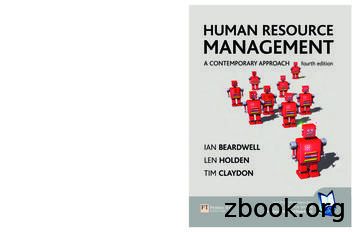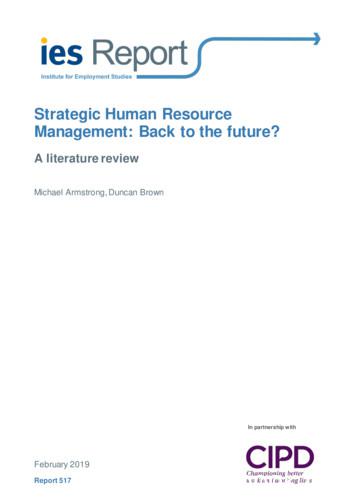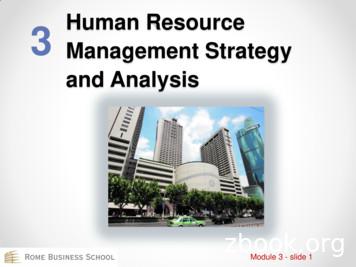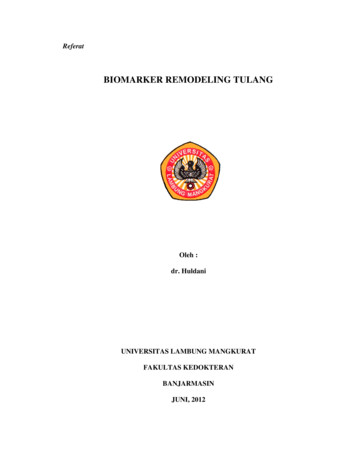2 Strategic Human Resource Management
2Strategic Human Resource Management .Strategic HumanResource Management(A New Perspective for Steel Industry)Dr. P.K. MohantyMUMBAI NEW DELHI NAGPUR BENGALURU HYDERABAD CHENNAI PUNE LUCKNOW AHMEDABAD ERNAKULAM BHUBANESWAR INDORE KOLKATA GUWAHATI
Role of Strategic Human Resource Management (SHRM): Key to . 3AuthorNo part of this publication may be reproduced, stored in a retrieval system, ortransmitted in any form or by any means, electronic, mechanical, photocopying,recording and/or otherwise without the prior written permission of the publishers.First Edition : 2014Published by:Mrs. Meena Pandey for Himalaya Publishing House Pvt. Ltd.,“Ramdoot”, Dr. Bhalerao Marg, Girgaon, Mumbai - 400 004.Phone: 022-23860170/23863863, Fax: 022-23877178E-mail: himpub@vsnl.com; Website: www.himpub.comBranch Offices:New Delhi:Nagpur:Kundanlal Chandak Industrial Estate, Ghat Road, Nagpur 440 018. Phone: 0712-2738731, 3296733; Telefax: 0712-2721216Bengaluru:No. 16/1 (Old 12/1), 1st Floor, Next to Hotel Highlands,Madhava Nagar, Race Course Road, Bengaluru - 560 001.Phone: 080-22286611, 22385461, 4113 8821, 22281541Hyderabad:No. 3-4-184, Lingampally, Besides Raghavendra SwamyMatham, Kachiguda, Hyderabad - 500 027.Chennai:8/2 Madley 2nd street, T. Nagar, Chennai - 600 017.Mobile: 09320490962Pune:First Floor, "Laksha" Apartment, No. 527, Mehunpura,Shaniwarpeth (Near Prabhat Theatre), Pune - 411 030.Phone: 020-24496323/24496333; Mobile: 09370579333Lucknow:House No 731, Shekhupura Colony, Near B.D. ConventSchool, Aliganj, Lucknow - 226 022.Ahmedabad:Ernakulam:“Pooja Apartments”, 4-B, Murari Lal Street, Ansari Road,Darya Ganj, New Delhi - 110 002.Phone: 011-23270392, 23278631; Fax: 011-23256286Phone: 040-27560041, 27550139Phone: 0522-4012353; Mobile: 09307501549114, “SHAIL”, 1st Floor, Opp. Madhu Sudan House, C.G.Road, Navrang Pura, Ahmedabad - 380 009.Phone: 079-26560126; Mobile: 0937708884739/104 A, Lakshmi Apartment, Karikkamuri Cross Rd.,Ernakulam, Cochin - 622011, Kerala.Phone: 0484-2378012, 2378016; Mobile: 09387122121Bhubaneswar :5 Station Square, Bhubaneswar - 751 001 (Odisha).Phone: 0674-2532129, Mobile: 09338746007Indore:Kesardeep Avenue Extension, 73, Narayan Bagh, Flat No. 302,IIIrd Floor, Near Humpty Dumpty School, Indore - 452007 (M.P.).Mobile: 09303399304Kolkata:108/4, Beliaghata Main Road, Near ID Hospital, Opp. SBI Bank,Kolkata - 700 010, Phone: 033-32449649, Mobile: 7439040301Guwahati:House No. 15, Behind Pragjyotish College, Near SharmaPrinting Press, P.O. Bharalumukh, Guwahati - 781009, (Assam).Mobile: 09883055590, 08486355289, 7439040301DTP by:AshaPrinted at:M/s. Aditya Offset Process (I) Pvt. Ltd., Hyderabad. On behalf of HPH.
4Strategic Human Resource Management .Dedicated toSRI SRI SHIRDI SAI BABA
Role of Strategic Human Resource Management (SHRM): Key to .5FOREWORDGlobalization of business has changed the scenario of managementin the country. The times are changing and there is an increasing need tocope with the ever changing forces of competition, the technologicalonslaught and the growing realization of knowledge management. Thenew economic environment has compelled the leaders and managers oforganizations to look forward – to understand the rules of survival intheir business and beyond mere survival to set their organizations on thepath of prosperity and growth. Today, the HR function has a morestrategic role. A changing business environment can influence theoutcome of current operations, stakeholders and corporate strategy as awhole. Since 1990, there has been an increased focus on strategic role ofHuman Resource Management (HRM) and now HRM has becomestrategic in nature. Strategic Human Resource Management (SHRM) isconcerned with the relationship between HRM and StrategicManagement in an organization.This book brings to light the strategic human resource approaches,which are needed to cope with the changing business environment. Italso helps to bring overhauling organizational excellence by identifyingpitfalls and timely attributing corrective measures through need-basedHR strategy. This book emphasizes on post-liberalization effects andperformance of SAIL and TATA STEEL from 1991 till date with focuson HR initiatives and other turnaround strategies to make organizationas profitable and competitive as possible. The true insights of free andfrank opinions of more than two hundred employees of SAIL and TATASTEEL, captured by the author about the implementation of variousturnaround business alignment strategies in this book is foundinteresting and praiseworthy.I believe that this book “SHRM – A New Perspective for SteelIndustry” will serve as professional companion to management students,researchers and HR managers.Dr. K.K. RayProfessor,IIM, Raipur
6Strategic Human Resource Management .PREFACELiberalization and Globalization has changed the scenario ofmanagement in the country. Today, we look forward to competition atglobal market. It is not enough to just manage an organization but needof the hour is to manage any organization with effectiveness andefficiency. Today, Human Resource Management should be viewed asstrategic function not as routine function. It can facilitate achievementsof goals of the organization as HR strategy is linked with businessobjectives of the organization.Every business organization must adopt a corporate strategy tooperate in a global business environment if it wants to survive. Nocompany, either big or small, will be able to continue its successfuloperation with a secluded business philosophy in the years to come.Hence, only way to go ahead is to adopt a strategic managementphilosophy for a global market.The liberalization of 1991 has exposed the Indian companies,which were under protection for over four decades, to a process ofglobalization. Now, global companies are very much here in Indiaputting forward a strong competition. Evidently, Indian companies haveno option but to change their outlook, philosophy, programmes,priorities, perspectives and their business strategies. They have to acceptthe new challenges and improve their efficiency and quality to suit theglobal standard and extend their operational canvas to other nations.The book “Strategic HRM – A New Perspective for Steel Industry”is exclusively focusing post-liberalization effect on India’s steel industry,with special emphasis on SAIL and TATA STEEL as well as their HRstrategies, business policies and strategic planning perspective.This book is organized into eight chapters. Chapter I, focuses onstrategic role of Human Resource Management (HRM) and how HRMhas become strategic in nature after globalization of business.Chapter II introduces the global scenario of steel business andIndian steel industry after liberalization.Chapter III emphasises on TATA Steel and SAIL’s endeavorduring post-liberalization period.Chapter IV focuses on the scope and methodology of the study.
Role of Strategic Human Resource Management (SHRM): Key to .7Chapter V describes performance of Indian Steel Industry duringpre-liberalization period from 1985 to 1990 with specific study onperformance of SAIL & TATA STEEL.Chapter VI emphasizes on post-liberalization effects andperformance of SAIL & TATA STEEL from 1991 till date. Executivestudy is being done on modernization process, performancemanagement, HR initiatives, other turnaround strategies with referenceto literature survey, analysis of corporate plans, in-house journals andmanuals, etc. This Chapter also includes a case study of turnaroundstory of Rourkela Steel Plant (RSP). The study is based on majorturnaround and implementation strategies adopted by the CEOs to makethe organization as profitable and competitive.Chapter VII is the main theme of the book, where the opinions ofexecutives and workmen of SAIL & TATA STEEL are analyzed withquestionnaire form and statistical analysis are being made to know theaccuracy of study. Major focus is given on global HR and IR issues,global business policies, new HR policies, restructuring of manpower,HR strategies linked with business philosophy, vision and mission,strategic human resource perspectives, Knowledge Management,Compensation, Recognition system, Training and Development,Recruitment and Promotion policies, and impact on IR issues. Further,the hypotheses are tested through statistical methods to establish theeffectiveness of the statement adopted for the above study purpose.Chapter VIII deals with findings of the study and conclusion,focused on process of liberalization changes in SAIL & TATA STEELthat constitutes useful learning for managing their respective futures.Based on results of analysis, the conclusions show the direction ofchange process initiatives adopted by SAIL & TATA STEEL arepositive and growth-oriented. At last, some suggestions andrecommendations are given to accelerate the change initiatives of boththe organizations (SAIL & TATA STEEL) and make them consistentresult-oriented.This book is intended for all HR Professionals, ManagementStudents and Researchers and Steel Industry Personnel. I believe, it canserve as an effective guide and reference to them for implementation ofHR strategies aligned with business goals of respective organizations.Dr. P. K. Mohanty
8Strategic Human Resource Management .ACKNOWLEDGEMENTSI express my gratitude to Dr. P.K. Mohanty, Professor, Departmentof Business Administration, Utkal University and Dr. K.M. Sahoo,Ex-Professor, Department of Personnel Management & IndustrialRelations, Utkal University for their guidance and support.My sincere thanks to Mr. Avinas Prasad, Ex-VP (IR), Mr. NadeemKazim, Head (Management Development), Mr. R.N. Mishra, Head(IR – Legal), TATA STEEL, Mr. S.N. Patnaik, DGM (IndustrialEngineering), Mr. Rehaman Khan, DGM (Town Admn.), Mr. P.K.Mohanty, Mr. A.K. Bose of Rourkela Steel Plant for their valuablesupport and help during my visits for data collection. My sincere thanksto SAIL Management (RSP, BSP, Bokaro Steel Plant, DSP, Salem SteelPlant, CMO and Corporate Office) and TATA STEEL Management fortheir constant support and help provided me during my frequent visit totheir respective organizations. I thank all the respondents whoparticipated in this study. Without their cooperation, this study could nothave been completed.I appreciate my friend, Dr. P.K. Das, Reader in Chemistry, GMCollege, who has contributed some suggestions to improve my qualityof work.I am particularly thankful to Mr. Ghanashyam Parida, Senior Asst.,OPTCL for his personal interest in rendering service of typing andcomputer graphics for this book.Special thanks are due to Mr. Rabindra K. Maharana, Mr. TrinathDas, Mr. Bireswar Pati, Mr. Gaurav Das, Dr. Himansu Sekhar Nanda,Mr. Himansu Patnaik and Mr. Joga Jeeban Sahoo for their continuoussupport and suggestions while editing the book. I am grateful toMr. Anil Sehgal, Director, Amtek Group of Companies for hisunstinting support, encouragement and inspiration throughout thepreparation of this book.I am thankful to Mr. P.C. Panigrahi, Director (Personnel),Mahanadi Coalfields Ltd (MCL) for his valuable guidance whilepreparation of this book.
Role of Strategic Human Resource Management (SHRM): Key to .9I am grateful to Mr, Niraj Pandey. Director and Mr. Bijoy K. Ojha,Manager and Staff of Himalaya Publishing House Pvt. Ltd. for theirkeen interest in publishing this book.I am indebted to my parents, who have been providing mecontinued love and inspiration to achieve success in life. At last but notleast, I express my heartfelt gratitude to my wife, Dr. Banalata Mohanty,Reader in Zoology, Dhabaleswar College of Science and Technology,Odisha who has been the driving force and inspiration behind thecompletion of this book.Dr. Prabodh Kumar Mohanty
10Strategic Human Resource Management .CONTENTS1. Role of Strategic Human Resource Management(SHRM): Key to Organizational Excellence1 – 132. Global Scenario of Steel Business and Indian SteelIndustry after Liberalization14 – 283 TATA STEEL & SAIL’s Endeavour duringPost-liberalization Period29 – 454. Scope and Methodology of Study46 – 525. Performance of Indian Industry duringPre-liberalization Period from 1985 to 1990with Specific Study on SAIL & TATA STEEL53 – 826. Post-liberalization and Performance ofSAIL & TATA STEEL (1991 to 2013)83 – 2107. Executives’ & Workmen’s Opinion Poll(SAIL & TATA STEEL) and StatisticalAnalysis of Results211 – 2648. Findings of the Study and Conclusion265 – 289Appendices290 – 307
Role of Strategic Human Resource Management (SHRM): Key to .11LIST OF TABLESTableNo.SubjectPage No.2.1World’s Largest Economies (GDP in US Billion)162.2County-wise Crude Steel Production212.3County-wise Crude Steel Production (2011-12)222.4Overview of Indian Steel Industry (Crude SteelProduction 2006-11)222.5Import of Finished (Carbon) Steel during 2001-02 to2011-12242.6Production of Pig Iron and Finished (Carbon) Steelsince 2002-03 to 2011-12243.1Net Profit of TATA STEEL (2009 to 2013)325.1A Picture of the Central Government Public Sector555.2Performance of the Top 15 Public SectorUndertakings of the Central Government565.3Employment in the Public Sector of India inComparison with the Private Sector575.4Thrust Activity (1985-90)646.1Directors’Workshops886.2Savings on Techno-economic Parameters1036.3Strategic Thrust Areas1066.4Production Capacity of SAIL after Expansion thePresent Annual Capacity of Rourkela Steel Plant1186.5Manpower Trend1546.6Post-expansion of Production Plants – RSP1546.7Post-expansion Production Plant (in Million Tonsper annum)1586.8TATA STEEL’s SGA Performance in 20051856.9TATA STEEL’s Suggestion ManagementPerformance for 20051866.10Scores given by World Steel Dynamics to 12 Worldclass Steel Makers (Score of 1 on a Parameter is191
12Strategic Human Resource Management .Lowest and 10 Highest)7.1Statistical Analysis of Questionnaires (SAIL &TATA STEEL Executives)2127.2Statistical Analysis of Questionnaires (SAIL &TATA STEEL Executives)2207.3Statistical Analysis of Questionnaires (SAIL &TATA STEEL Executives)2257.4Statistical Analysis of Questionnaires (SAIL &TATA STEEL Executives)2307.5Statistical Analysis of Questionnaires (SAIL &TATA STEEL Executives)2327.6Statistical Analysis of Questionnaires (SAIL &TATA STEEL Executives)2367.7Statistical Analysis of Questionnaires (SAIL &TATA STEEL Executives)2417.8Statistical Analysis of Questionnaires (SAIL &TATA STEEL Workmen)2447.9Statistical Analysis of Questionnaires (SAIL &TATA STEEL Workmen)2477.10Statistical Analysis of Questionnaires (SAIL &TATA STEEL Workmen)2507.11Statistical Analysis of Questionnaires (SAIL &TATA STEEL Workmen)2567.12Statistical Analysis of Questionnaires (SAIL &TATA STEEL Workmen)2587.13Statistical Analysis of Questionnaires (SAIL &TATA STEEL Workmen)2608.1Performance Related to Pay (Ref: Vicky Wright)277
Role of Strategic Human Resource Management (SHRM): Key to .13LIST OF FIGURESFigureNo.SubjectPage No.1.1Components of SHRM21.2Recommended Model of SHRM101.3HRM Strategic Model111.4Model of SHRM112.1Factors Influencing Global Business172.2Crude Steel Production in 2011233.1The Big League in Steel Production Capacity(in Million Tons)315.1Production Highlights (Million Tons)(1985-86 to 1990-91)615.2Profit (1985-86 to 1990-91) (in Billion)626.1Year-wise Profit (1993-2000)996.2Production (1993-94 to 1999-2000)996.3Overview of SAIL (Figures in Bracket are CrudeSteel Production Capacity in Million Tons)1146.4Production Performance of Saleable Steel of SAIL(MT)1156.5Manpower Productivity1226.6Sales Turnover1246.7Exports (Million Tons)1256.8Steel Consumption in India1306.9Framework for Unlearning and Relearning1326.10Crude Steel Production of RSP1536.11Organization Set-up of RSP1536.12Labour Productivity1546.13Year-wise Profit – RSP1556.14Samskar Model1566.15AVG Converter Life in SMS-I1576.16AVG Converter Life in SMS-II1586.17TATA STEEL at the Strategic Inflection Point in1991167
14Strategic Human Resource Management .6.18Vision-2007 of TATA STEEL1706.19TATA STEEL: Building Blocks to Excellence1746.20Pathway to Business Excellence through the MalcolmBaldridge Model1756.21TPM at TATA STEEL1846.22Various Phases of Knowledge Management at TATASTEEL1876.23Year-wise Profit (TATA STEEL)1896.24Corporate Governance of Tata Group1936.25Process Innovation across the Entire Supply Chain1956.26Potential Impact of e-commerce1966.27Year-wise Production of TATA STEEL2067.1Strategic Human Resource Perspective2287.2The Performance Management Model(Ref. Pam Pocock)2527.3Values Underlying Organizational Change(Ref: David Packard)2537.4Leadership Mission Model2558.1Changing Role of HR (Ref: Ashok Chanda and ShilaKabra)2758.2HR Strategy House Model (Ref: Ashok Chanda andShila Kabra)276
Role of Strategic Human Resource Management (SHRM): Key to .Chapter115Role of StrategicHuman ResourceManagement (SHRM):Key to OrganizationalExcellenceLearning Outcomes:When you finish this chapter, you should: Be able to differentiate between HRM and Strategic HRM Know about need of SHRM. Understand linkage of HR Strategy into business strategy. Envisage outsourcing and co-sourcing. Be familiar through various SHRM models for organizationalexcellence. Know internalization of Human Resource Management – alearning outcome for strategic perspectives.ROLE OF STRATEGIC HUMAN RESOURCEMANAGEMENT (SHRM): KEY TO ORGANIZATIONALEXCELLENCEWith increasing competition and changing economic and businessenvironment, many CEO’s have recognized people’s capabilities as acompetitive advantage and therefore, HR has become an important and acritical business function. Since 1990, there has been an increased focuson the strategic role of Human Resource Management (HRM) and nowHRM has become strategic in nature. Strategic Human ResourceManagement (SHRM) is concerned with the relationship between HRMand Strategic Management in an organization.Strategic Human Resource Management is an approach whichrelates to decisions about the nature of employment relationship,recruitment, training and development, performance management,reward and employee relations.
16Strategic Human Resource Management .Wright and Mc Mahan (1992) defined SHRM is the pattern ofplanned human resource deployment and activities intended to enablethe firm to achieve its goals.Need of SHRM To ensure the availability of a skilled, committed and highlymotivated workforce in the organization to achieve sustainedcompetitive advantage. To provide direction to the organization so that both thebusiness needs of the organization and the individual andcollective needs of its workforce are met. This is achieved by developing and implementing HR practicesthat are strategically aligned.Four Components of SHRM4. Clear cut &meaningful peopleactivities, policies& procedures toachieveorganizationalexcellence1. HR primary sourceof competitiveadvantagesSHRM3. Patterns & plans,HR StrategyIntegration into aBusiness Strategy.2. Activities of HRProgrammes andpractices.Fig. 1.1: Components of SHRMBecause of relentless process of Globalization, companies facesimilar problems in the market place. In order to be successful, theymust adopt similar solutions to these common problems.HR is becoming more strategic on two counts. First, HR is a riskmanager and second, HR facilitates the growth of engagement capital,
Role of Strategic Human Resource Management (SHRM): Key to .17both of which have a huge impact on franchise valuation. Traditionalengagement approaches provide a readymade solution but the lack oflong-term benefits and perspectives which ignores up to 70% of thereasons why employees disengage.Today’s HR professionals contribute to creating engagementcapital to improve employee effort, retention and key business outcomes.As we balance short-term improvements with engagement drivers thatsustain engagement overtime, there is a greater alignment of the HRfunction to an organization’s strategic needs. One of the key pi
Human Resource Management (HRM) and now HRM has become strategic in nature. Strategic Human Resource Management (SHRM) is concerned with the relationship between HRM and Strategic Management in an organization. This book brings to light the strategic human resource approaches, which are
Strategic human resource management John Bratton Chapter two Strategic human resource management is the process of linking the human resource function with the strategic objectives of the organization in order to improve performance. ‘If a global company is to function successfully, strategies at different levels need to inter-relate.’1
Human resource management: the state of the debate 24 Summary 27 Activity 28 References and further reading 29 2 Strategic human resource management Nicky Golding 32 Objectives 32 Introduction to strategic human resource management 32 Understanding the business context 34 Approaches to the strategy-making pr
2 Strategic Human Resource Management: Back to the future? Executive Summary More than 30 years after the concept of strategic human resource management first started to be adopted in the UK, IES and CIPD are undertaking a joint piece of research into the contemporary state of human resource management and people management strategies in the UK.
Part 2: Strategic human resource management in action. This describes the formulation and implementation of HRM strategies, the impact of strategic human resource management, the strategic contribution of the HR function, and roles in strategic HRM. Part 3: HR strategies. This covers each of the main areas in which HR
Define strategic human resource management and give an example of strategic human resource management in practice. 5. Briefly describe three important strategic human resource management tools. 6. Explain the importance of
Champaign. 2017 . Strategic Compensation: A Human Resource Management Approach 9th Edition Book by Joseph J. Martocchio, University of Illinois at Urbana-Champaign. Joseph J. Martocchio's most popular book is Human Resource Management. . Strategic Compensation: A Human Resource Management Approach . Edition Plus MyManagementLab with
Human Resource Management Human Resource Policy QUADRANT-I Module 4: Human Resource Policy 1. Learning Outcome 2. Definition 3. Employee understanding on HR Policy 4. Benefits of policy 5. Specific Personal policies 6. Responsibility for policy making 7. Formulation of Human Resource Policy 8. Principles 9. Procedures 10. Programs 11. Summary 1.
tulang dan untuk menilai efektivitas hasil pengobatan. Hasil pemeriksaan osteocalcin cukup akurat dan stabil dalam menilai proses pembentukan tulang. Metode pemeriksaan osteocalcin adalah enzyme-linked immunosorbent assay (ELISA). Nilai normalnya adalah: 10,1 9,4 ng/ml.8 Setelah disintesis, OC dilepaskan ke sirkulasi dan memiliki waktu paruh pendek hanya 5 menit setelah itu dibersihkan oleh .























